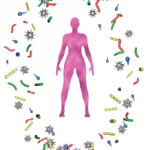Gut Dysbiosis–Joint Links
What is the link between immune responses in RA patients’ gut mucosa and what is happening in their joints? One hypothesis is that T cell epitope mimicry between microbial proteins in patients’ guts and the host proteins in their joints trigger cross-reactive, autoimmune responses that affects their joints, said Dr. Steere.
The National Institutes of Health (NIH) database on T cell epitopes from human and microbial sources shows that up to six of the nine amino acids in the HLA-DR-binding groove commonly overlap between human and microbial proteins. However, cross-reactive T cell epitopes are more common between human proteins and commensal bacterial proteins than with pathogenic bacteria, he said. This suggests many foreign epitopes would be recognized by self-reactive T cells.13
“Why would there be more T cell epitope mimicry between host proteins and those of commensal organisms than with those of pathogens?” asked Dr. Steere. It may relate to the importance of generating T-regulatory cells. “However, one could also hypothesize, that under certain circumstances, due to the plasticity of the Th-cell repertoire, that some T-reg cells may become Th17 cells that have a pathologic function.”
Dr. Steere’s laboratory’s research found that the GNS peptide had a 67% sequence homology with a Prevotella aryl-sulfatase protein, and these peptides share amino acid identity at the P1, P4 and P6 sites. They also found the FLNA peptide had 80% sequence homology with a secreted Prevotella protein, with seven of nine identical amino acids in the binding groove.14 They found T cell reactivity to both the GNS peptide and the related Prevotella peptide in about one-third of RA patients.
These patients often reacted with a similar epitope of a sulfatase protein of Parabacteroides species. About one-third of RA patients had T cell reactivity to both the FLNA sequence and the related Prevotella sequence, and to a similar sequence in Butyricimonas.
In each case, the higher the T cell reactivity to the microbial peptide, the higher the response to that self-peptide. They also found positive correlations between patients’ IgG and IgA P. copri antibodies, and their GNS or FLNA antibodies, a correlation not seen with P. gingivalis antibodies, he said.
“Our second hypothesis was based on the finding of Prevotella DNA in joint fluid in some patients with IgG P. copri antibodies. We hypothesized that P. copri or its remnants may spread directly to joints, presumably within cells. It’s an anaerobe, so it’s not going to survive well in the bloodstream in an aerobic environment,” he said. “Perhaps P. copri or its components may reach the joints in APCs [antigen-presenting cells], where they could stimulate joint inflammation.”
Past research has shown PCR positivity for the DNA of various bacterial organisms in the joints of patients with RA, reactive arthritis or osteoarthritis, said Dr. Steere.
“It’s been hard to know what to make of that. Is it simply an epiphenomenon? One has this image of DNA from the bowels floating around systemically and then occasionally getting into the joints.” He and his colleagues conducted nested PCR testing of matched samples of serum joint fluid from 18 RA patients. Importantly, they detected Prevotella 16S DNA in the synovial fluid of three patients, and found that they had IgG antibody responses to P. copri.
“What’s different here is the clinical correlation between P. copri DNA in joints and P. copri IgG antibody responses, which suggests this may be more than an epiphenomenon,” said Dr. Steere. “Those three patients were among the five who had IgG antibody responses to P. copri. We did not find this in the patients with IgA responses or in those who were negative for P. copri antibody responses.”
When the PCR products from the three patients were sequenced, each had a slightly different sequence, which may be explained by the fact that each patient grew up in a different geographic region. Different sequences show this result could not be explained by cross-contamination among the three samples, he said.
Although this hypothesis seems bold, bacteria–inflammation links are found in other diseases, including cancer, said Dr. Steere. A 2013 study showed that a commensal anaerobe found in the oral cavity implicated in periodontal disease, Fusobacterium nucleatum, has the potential to spread, bind to adenomatous polyps in the bowel, and induce inflammatory and oncogenic changes, leading to colorectal adenocarcinoma cells. In a mouse model, an inhibitory 11 amino acid peptide blocked this binding and prevented oncogenesis.15
Rheumatologists should consider the implications of these findings for future diagnosis and treatment of RA, he concluded.
“Will we someday need to determine a site of mucosal involvement in patients with new-onset RA? And the earlier, the better? Will we test not just for rheumatoid factor and ACPA, but also for antibody responses to certain commensals and/or related auto-antigens? I suspect that the answer is yes,” said Dr. Steere.
Patients with gut-associated antibody responses might be treated not only with DMARDs, but with directed antibiotics, probiotics or diet to restore normal commensal balance in their bowels. “Will we someday be able to target pathogenic microbial or host T cell epitopes using blocking peptides? Identification of pathogenic T cell epitopes, which may require precision medicine, may make this possible.” This strategy has shown encouraging results in several allergic and autoimmune diseases, he said.16
Dr. Steere closed by acknowledging the contributions of several co-investigators to this ongoing research, including Drs. Annalisa Pianta, Klemen Strle, Catherine Costello and Elise Drouin.


